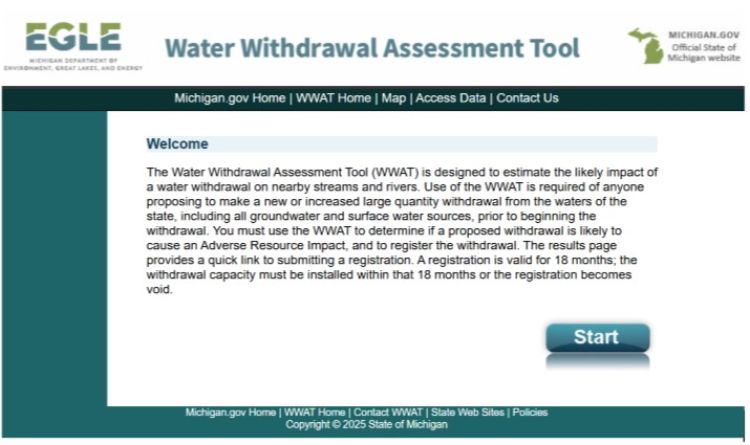How to access water withdrawal information post-2008 from the MIWATT (Michigan’s Water Withdrawal Assessment Tool) website.
Michigan’s Water Withdrawal Assessment Tool (MIWATT) data can be helpful when looking at nearby withdrawals or checking on a withdrawals status is unknown.

The Michigan Water Withdrawal Assessment Tool (MIWWAT) is an online tool designed to estimate the potential impact of proposed water withdrawal on nearby streams and rivers. The tool is a regulatory requirement for anyone planning to initiate or increase a large quantity withdrawal from Michigan’s groundwater or surface water sources. Large quantity withdrawals are defined as having the capacity to withdraw 100,000 gallons per day or more. This is equivalent to a pump capacity of at least 70 gallons per minute and accounts for the total combined capacity of all pumps operating on the property.
On the MIWWAT website, the “New Registered Withdrawal Information” data file is an updated list of all requested water withdrawals within the state of Michigan. The file is updated continuously and shows records from as far back as December 8, 2008. The Excel sheet shows the pump capacity, depth, source, location (Lat/Long), county, discharge and purpose of all the withdrawals registered. This can be helpful when looking at nearby withdrawals or checking on a withdrawals status is unknown. If you are looking for information on withdrawals before December 2008, please contact the Michigan Department of Agriculture & Rural Development (MDARD) at eatona@michigan.gov.
The MIWWAT database can be used by large-volume water users in several situations:
- Producers can identify the other large-volume water users within the watershed that they may work with if reductions in use are needed to allow for new uses.
- Producers seeking to add or expand water use within a watershed where no allocations are available can use the database to search for withdrawals that were either never installed or are under-used. Negotiations with landowners of the property hosting an under-used allocation would then be needed to reduce their allocation to make room for the new or expanded withdrawals. EGLE must be notified of reduced withdrawals and of withdrawals that were never installed and are past their 18-month registration period to update watershed allocations.
- Some watersheds may have historical (pre-2008) water withdrawals incorrectly entered into the MIWWAT. Producers finding these errors should notify EGLE that the documented historical water use should be removed from the MIWWAT and registered as a pre-2008 (historical) registration, making more water available in the MIWWAT for new withdrawals.
- Having accurate information is essential. It is important that you check the latitude, longitude and capacity of the withdrawals you have reported to the state annually, to ensure they are located properly. This is especially so for withdrawals first reported prior to 10-01-2008. You can use the map function in the Water Use Reporting database or google maps to do so. If corrections are necessary, please notify MDARD or EGLE.
- As watersheds enter the phase of no longer having allocations available, producers will likely have to work together to allow any expansion of large volume water use. One possible method of expanding large volume water use within a watershed is to convert from direct withdrawals from the river or stream to wells on adjacent properties. Information from the MIWWAT database can be used to find direct withdrawals that have the greatest potential for reduction in their allocation if converted to groundwater wells. The much lower estimated impact value for wells in the MIWWAT than direct withdrawals can allow several wells with higher total production capacity to be constructed. The removal of a single large direct withdrawal from the watershed may create the option of two or three groundwater wells.
You can use this video link to watch and follow the step-by-step to access the requested water withdrawal information.
If you have any questions about the water withdrawal registration, you can click “Contact Us” on MIWWAT website to send EGLE an email.



 Print
Print Email
Email


